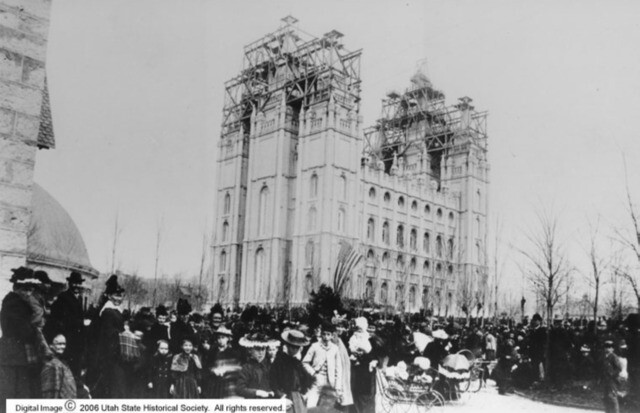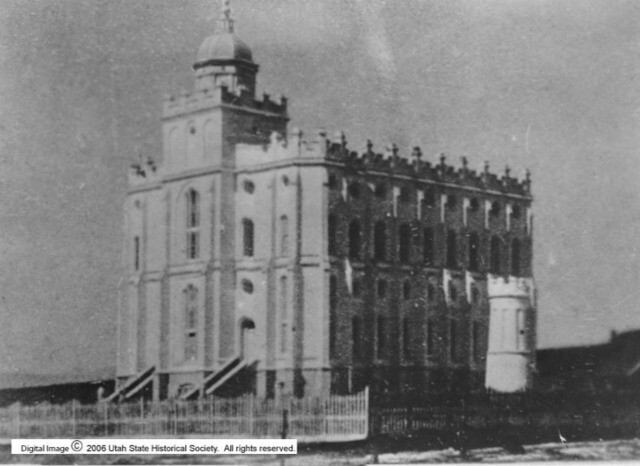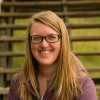Editor's note: This is the first in a series of articles, “Scenes from Saints,” a series highlighting interesting facts from Saints volume 2. Articles will be posted weekly during November and December 2020. You can purchase both volumes of Saints through Deseret Bookor read and listen to the volumes on the Gospel Library app under the “Restoration and Church History” section.
Can ‘Church history’ and ‘cliff hanger’ be used in the same sentence? I didn’t think so until I started listening to the Church's new Saints series with my husband. While many of the stories and details in the first volume (Saints, Vol. 1: The Standard of Truth) were at least familiar or expected, I was surprised by the number of things I didn’t know from the second volume (Saints, Vol. 2: No Unhallowed Hand). Chock-full of the good and bad that came with settling in Utah and living a new religion, the book covered everything from building temples and growing missionary work to struggles with polygamy, details surrounding the horrifying events of Mountain Meadows, and glimpses into the lives of members from Europe to the islands. In fact, I came away with so many tidbits to share that I have broken them down into a series of posts that I hope you will find as interesting as I did. Below you will find a fact, an excerpt from the book, and a link to read more. Let’s get started!
St. George Utah Temple
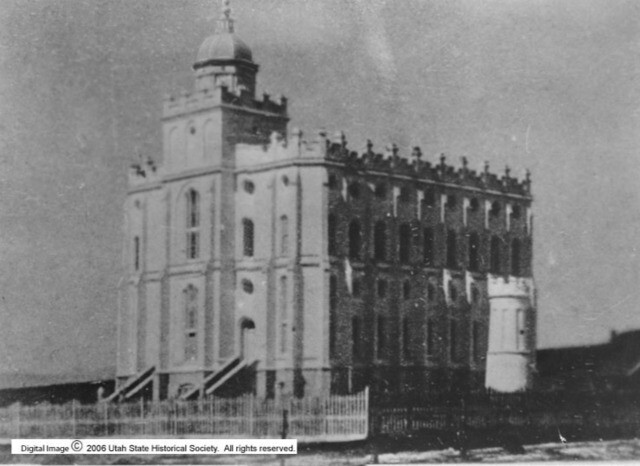
Image of the St. George Utah Temple from the Utah State Historical Society
1. A party was held by every ward to raise money for the St. George temple.
“Later that year, every ward in Salt Lake City held a party to raise money to finish the St. George temple. Knowing twenty-year-old Heber Grant was a reliable young man with many friends, Bishop Edwin Woolley of the Thirteenth Ward asked him to organize his ward’s party. ‘I want you to make a success of it,’ he told Heber.”
Learn more about these parties in chapter 28.
2. The St. George temple became the location for the first endowment for the dead and was the first place white clothing was worn in the temple.
“On January 9, Wilford Woodruff waded into the temple’s baptismal font with Brigham’s daughter Susie, now eighteen years old and married to a young man named Alma Dunford. Using a crutch and walking stick, Brigham stood as witness as Wilford baptized Susie for one of her deceased friends, the first baptism for the dead in the St. George temple. Afterward, Wilford and Brigham laid their hands on Susie’s head and confirmed her on the deceased’s behalf.
“Two days later, Wilford and Brigham supervised the first endowments for the dead performed in any temple. Wilford then spent nearly every day afterward doing temple work. He began wearing a white suit, the first time someone had worn white clothes rather than normal dress clothes as part of the temple ceremonies. Susie’s mother, Lucy, who likewise dedicated herself to temple work, wore a white dress as an example for women.”
Read more about these events in chapter 28.
3. After the St. George temple was dedicated, Brigham Young began asking Wilford Woodruff and others to write down the temple ordinances for the first time.
“As Wilford worked in the temple, Brigham asked him and other Church leaders to write out the endowment ceremony and the other temple ordinances. Since the time of Joseph Smith, the words of the ordinances had been preserved only through word of mouth. Now that the ordinances would be performed at a distance from Church headquarters, Brigham wanted the ceremonies written down to ensure that they would occur the same way in each temple.
“In standardizing the ordinances, Brigham was fulfilling a charge Joseph Smith had given him after the first endowments in Nauvoo. ‘This is not arranged right, but we have done the best we could under the circumstances,’ Joseph had told him then. ‘I wish you to take this matter in hand and organize and systematize all these ceremonies.’”
Learn more about this in chapter 28.
Logan Utah Temple

Image of the Logan Utah Temple from the Utah State Historical Society
4. A group of Shoshone, including a Shoshone leader named Sagwitch, helped build the Logan temple.
“That spring, in northern Utah, Sagwitch, his wife Moyogah, and sixteen other Shoshones ascended the hill leading to the Logan temple. The temple had been finished and dedicated a year earlier, a testament to the faith and hard work of Saints in northern Utah and southern Idaho. Among those who had labored tirelessly to build the temple were Sagwitch and other Shoshone Saints.
“The Shoshones had traveled a long road to reach the temple. Twelve years had passed since Sagwitch and over two hundred other Shoshones had joined the Church. They worshipped in their own ward and in their own language. Sagwitch and Moyogah had been sealed in the Endowment House, and Sagwitch’s son Frank Timbimboo Warner had been called as a missionary among the Shoshones.”
Learn more in chapter 34.
Salt Lake Temple
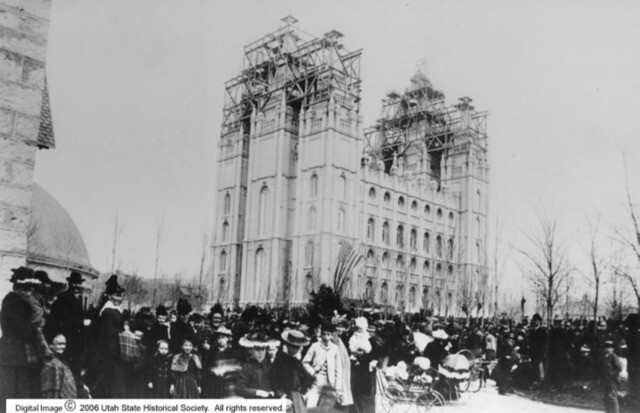
Image of the Salt Lake Temple capstone ceremony from theUtah State Historical Society
5. The foundation of the Salt Lake Temple remained buried nearly three years (from 1858 to 1861).
“A handful of Saints went east to take part in the war, but most Church members were content to stay in Utah and build up Zion. That summer, Brigham Young proposed to uncover the temple foundation, which had lain buried since the move south, and begin the temple walls. He also announced a plan, already underway, to build a large theater a few blocks from the temple site.”
Read more about the complications with the temple’s foundation after it was uncovered in chapter 21.
6. Original plans for the Salt Lake temple called for two assembly halls and spires made of wood.
“Over the next several months, the apostles accomplished much under Wilford’s leadership. Although the Manti temple was nearly ready to dedicate, the larger and more ambitious Salt Lake temple was still far from complete. The original plans for the temple had called for two large assembly halls to occupy the building’s upper and lower floors. While on the underground, however, John Taylor had considered a new floor plan that would eliminate the lower assembly hall, providing much more space for endowment rooms. Now, Wilford and the Twelve consulted with builders on the best way to carry out these plans. They also approved a proposal to finish the temple’s six towers in granite rather than in wood, as originally intended.”
Learn more about these plans in chapter 36.
7. In order to finish the exterior of the temple, an extra $175,000 needed to be raised.
“Shortly after George Q. Cannon opened the meeting, John Winder, a counselor in the Presiding Bishopric, reported to the assembly that it would take at least an additional $175,000 to finish the temple. Furnishing the inside would cost even more.
“Wilford Woodruff spoke of his earnest desire to have the temple completed on schedule. George then urged the men in the room to use their influence to raise the needed funds. Each stake would be expected to collect a certain amount based on its size and the means of individual families.
“The men in the room felt the Spirit powerfully and agreed to help. One man, John R. Murdock, recommended that all those present say how much they were personally willing to donate to the temple. One by one, the Church leaders pledged generously, promising a total contribution of more than $50,000.”
Learn more about the final stages of the temple’s construction in chapter 43.
8. Changes from the time of the original temple plans included electric lights, steam-powered heating, and elevators.
“George was especially impressed with the temple’s modern features. ‘It is surprising what changes have occurred through inventions since the first plan of the temple was drawn out,’ he wrote. Truman Angell, the temple’s original architect, had planned to warm and light the temple with stoves and candles. Now new technologies allowed the Saints to install electric lights and a steam-powered heating system throughout the building. Workers were also installing two elevators to help patrons move easily from one floor to another.”
Learn more about the Salt Lake temple plans in chapter 43.
9. Temple dedication sessions were held twice daily until every Church member who wanted to could attend.
“The days leading up to the dedication of the Salt Lake temple were full of energy and commotion. Work on the temple was still in progress on the day before the doors were scheduled to open. The city streets, meanwhile, were thronged with visitors arriving hourly by train, buggy, and horseback. Church leaders had decided to hold two dedication sessions a day until every Church member who wanted to participate could attend. Now tens of thousands of Saints were planning to come to Salt Lake City that spring to see the house of the Lord with their own eyes.”
Learn more about the dedication in chapter 44.
10. One of Brigham Young's daughters, Susa Young Gates, was the official reporter for all the dedicatory sessions.
“Inside the temple, Susa Gates sat down at the recorder’s table at the east end of the assembly room. As one of the official reporters of the dedicatory services, Susa would be taking shorthand minutes of the meeting. Even though she was just weeks away from giving birth, she planned to attend and report on every one of the dozens of scheduled sessions.”
Learn more about the dedicatory sessions in chapter 44.
11. Young Wilford Woodruff had visions of himself dedicating a temple in the mountains.
“President Wilford Woodruff then arose to address the Saints. ‘I have looked forward to this day for the last fifty years of my life,’ he said. As a young man, he had seen a vision of himself dedicating a magnificent temple in the mountains of the West. More recently, he had dreamed that Brigham Young had given him a set of keys for the Salt Lake temple.
“‘You go and unlock that temple,’ Brigham had said, ‘and let the people into it—all who want salvation.’
“After recounting these visions to the Saints, Wilford knelt on a cushioned stool to read the dedicatory prayer. Speaking in a strong, clear voice, he pleaded with God to apply the Savior’s atoning blood and forgive the Saints of their sins.”
Learn more about this sacred event in chapter 44.
12. During one of the dedicatory prayers, President Woodruff prayed that the Saints could remember how they had been helped in the past to help them get through future times of trouble.
“For over thirty minutes, Wilford offered thanks and gave praise to God. He presented the building to the Lord, asking Him to watch over and protect it. He prayed for the priesthood quorums, the Relief Society, the missionaries, and the youth and children of the Church. He prayed for the rulers of nations and for the poor, afflicted, and oppressed. And he asked that all people might have their hearts softened and be free to accept the restored gospel.
“Before closing, he asked the Lord to fortify the faith of the Saints. ‘Strengthen us by the memories of the glorious deliverances of the past, by the remembrance of the sacred covenants that Thou hast made with us,’ he prayed, ‘so that, when evil overshadows us, when trouble encompasses us, when we pass through the valley of humiliation, we may not falter, may not doubt, but in the strength of Thy holy name may accomplish all Thy righteous purposes.’”
Read more of President Woodruff’s prayer in chapter 44.
13. Special decorations sent by the Hawaiian Saints in Laie were displayed in the celestial room after the Salt Lake temple’s dedication.
“After presenting their recommends at the temple gates, the Iosepa Saints entered the building and walked through its many rooms. The Saints in Laie had sent a small table inlaid with Hawaiian hardwood for the temple, and two poles decorated with the feathers of Hawaiian birds were on display in one corner of the celestial room. Women in Hawaiian Relief Societies had crafted the poles, called kāhili, which symbolized royalty and spiritual protection.”
Learn more about the Hawaiian Saints gathered in Iosepa, Utah, in earlier chapters, or learn more about the temple’s interior in chapter 44.
Saints, Vol. 2: No Unhallowed Hand covers Church history from 1846 through 1893. Volume 2 narrates the Saints’ expulsion from Nauvoo, their challenges in gathering to the western United States and their efforts to settle Utah's Wasatch Front. The second volume concludes with the dedication of the Salt Lake Temple.


